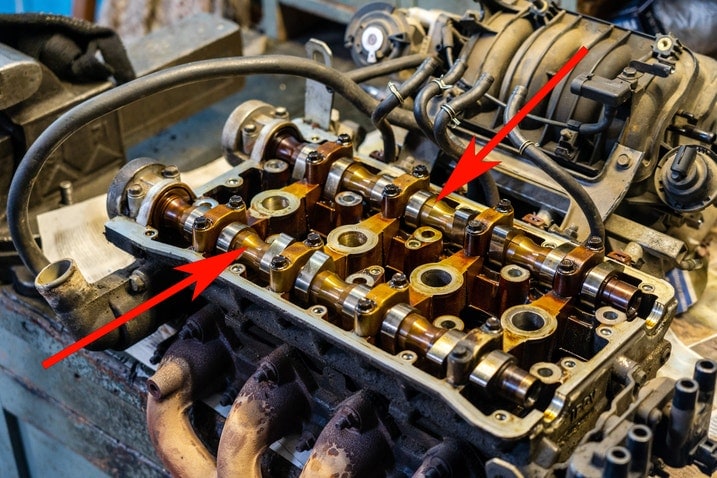Photo: Photo travelling people sports | iStock via Getty Images
A camshaft's primary function is regulating the opening and closing of the engine's air intake and exhaust valves. It's a harmonious operation that ensures fuel and air can enter the combustion chamber and exhaust gas can exit at optimum moments to benefit the engine's performance.
Types of camshafts
Camshafts come in various types and designs to optimize the engine's performance based on specific requirements. Let's explore different types of camshafts for automobiles:
Flat or tappet camshafts: These are the most basic and commonly used camshafts today. They have a flat surface on which the tappets or lifters ride. Due to wear and tear, flat or tappet camshafts require regular maintenance, including periodic lifter and camshaft replacement.
Roller camshafts: They feature roller bearings on their cam lobes, reducing friction and tear during use. Compared to flat or tappet camshafts, they're more durable and can handle higher rpmRPM and valve lift, making them common in high-performance engines.
Cast iron camshafts: These were common in older automotive engines because of their cost-effectiveness and durability. They've been historically favored for their resistance to wear and robustness, making them more suitable options for high-stress engine applications.
Steel billet camshafts: These are more high-performance options for engine builders looking for precise control over their camshaft specifications. Their precision performance and machining benefits make them the preferred choice for high-performance engine automobiles.
Interaction with other engine components
The camshaft interacts with several engine components to ensure smooth operation. The crankshaft is an integral engine component that works with the camshaft to regulate the valve's opening and closing timing. The two also regulate piston movement within the engine cylinders.
The crankshaft and camshaft's relationship is synchronized through the engine's timing belt. As the crankshaft rotates, it forces the pistons up and down inside the cylinders, converting linear and rotational motions.
During this time, the camshaft, also connected to the timing belt, rotates at half the crankshaft's speed. This relationship ensures that the cam lobes, which control the opening and closing of fuel and air intake into the engine and exhaust valves, operate in unison with the piston's movement.
The camshaft's profile dictates valve timing, specifically the precise movement when the valves open to allow fuel and air into the cylinders. Exhaust valves push exhaust fumes out of the cylinder. The four-stroke cycle is crucial in optimizing fuel efficiency, engine performance and emissions.
Considerations for replacement
Replacing or upgrading the camshaft is one of the best ways to ensure better engine performance and fuel efficiency. It's a critical step in making efficient power upgrades to the engine. However, critical considerations must be made to ensure camshaft compatibility, performance, and reliability after replacement.
Here are some key factors to keep in mind when replacing or upgrading a camshaft:
- Rocker arms
- Adjustable cam gear
- Valvetrain, including valves, seals and springs
- Engine rpm
- Piston clearance
- Fuel management
Carefully consider these factors when replacing or upgrading an engine's camshaft. We recommend seeking expert guidance to ensure successful replacement or upgrade for the engine's performance, reliability and longevity.
Maintaining a camshaft
Proper camshaft care and maintenance ensure smooth and efficient engine functioning. It also ensures optimal engine performance, longevity, and reliability throughout the engine's life. Some key steps to help car owners maintain their engine's camshaft effectively include the following:
Regular inspections
Keep the engine clean
Proper and regular lubrication
Check timing components regularly
Address performance issues promptly
Avoid over-revving the engine
Seek professional maintenance
Regular maintenance and timely repairs are critical to preventing costly damages and downtime associated with camshaft malfunctions or failures.
Common problems and solutions
Diagnosing and addressing common camshaft problems is the most effective way to maintain their efficiency and performance. This segment explores common issues that can arise with camshafts and discusses practical solutions to address them.
From wear and tear to performance issues, understanding these problems and their remedies is essential for maintaining optimal engine performance and longevity.
Wear and tear
Camshafts are subjected to significant mechanical stress and friction during engine operation, leading to wear and tear over time. Regular camshaft inspection is crucial to identify signs of wear and tear. Look for visible damage, such as scoring, pitting, or discoloration on the camshaft lobes and journals.
To prevent wear and tear on the camshaft, ensure proper and regular lubrication using high-quality engine oil and adhering to the recommended oil change intervals. Drivers should also maintain proper valve lash or clearance to prevent excessive wear on the camshaft lobes and valvetrain components.
Performance issues
Most engine performance issues can often be traced back to problems with the camshaft, crankshaft, or related components. Symptoms may include rough idling, misfires, loss of power, or poor acceleration. Diagnostic tests such as compression tests, cylinder leak-down tests, and examination of timing components can help pinpoint the cause of the performance issues.
Depending on the diagnosis, solutions to enhance performance may include replacing worn camshaft components, adjusting valve lash, or upgrading to a higher-performance camshaft profile. Proper fuel and ignition systems tuning may be necessary to optimize engine performance after camshaft replacement or modifications.
